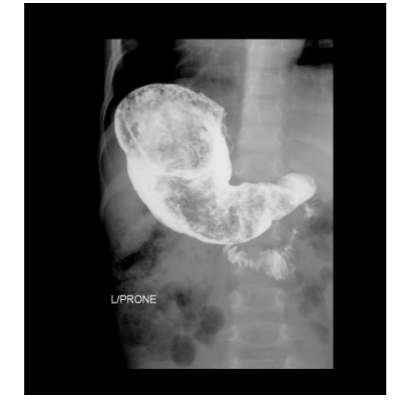Information
Journal Policies
Pyloric Obstruction in a Child - An Uncommon Cause
Iradj Amirlak2,John Denis Hardy1*,Chandrashekhar Anjikar3,Naief Sulaiman Khaled4
2.Consultant Paediatrician (Chief of Paediatric), Emirates International Hospital, UAE.
3.Consultant Radiologist, Emirates International Hospital, UAE.
4.CEO/Consultant General Surgeon, Emirates International Hospital, UAE.
Copyright :© 2018 Authors. This is an open-access article distributed under the terms of the Creative Commons Attribution License, which permits unrestricted use, distribution, and reproduction in any medium, provided the original author and source are credited.
A number of side effects from chewing and swallowing chewing gum have been described including possible tooth damage and temporomandibular joint disorders, but the most serious must be gastrointestinal obstruction with chewing gum being the base on which other ingredients are added to form a bezoar.
We describe the case of 3 years old boy who developed a large bezoar from chewing gum ingestion which caused obstruction. We also describe another child whose symptoms were probably from chewing gum ingestion.
Pyloric Obstruction,Child - An Uncommon Cause,Radiology and Medical Imaging
1. Case1
A nearly 4year old Syrian boy was admitted with a history of repeated vomiting which persisted in hospital for another day, In the past he had many admissions to other hospitals with prolonged vomiting episodes and he had abdominal ultrasounds which were always normal on some of the occasions.
A barium meal was performed on our patient (figures 1 and 2). It showed a large bezoar filling the whole stomach; a mottled mass not attached to the wall. (Some barium has passed through the pyloric canal so the obstruction is not total)
The viscous mass had to be surgically removed through a minor incision and gastric wall port. It consisted of chewing gum and fragments of food. Since then, more than 1 year ago, there have been no further problems.
We strongly suspect that chewing gum was responsible for gastrointestinal disturbances in a second child, a 5 ½ year old Syrian girl, who was admitted after vomiting 5 times and continued to vomit intermittently for 2 days while having IV Fluids and very little oral intake.
We know she was a frequent chewing gum taker, and had been taking chewing gum shortly before admission, but unlike the first child we have no proof that this was the cause.
2. Discussion
Deborah Gold1 in her interview reported in the BMJ answered the question “What is your pet hate?” with “People chewing gum.” She may have been thinking about the social and environmental aspects, but she would have good medical reasons to dislike it, too, at least in children. A number of side effects have been described from taking chewing gum including possible tooth damage and temporomandibular joint disorders5, but the most serious must be gastrointestinal obstruction with chewing gum being the base on which other ingredients are added.
This has been described before – bezoars both in the stomach and in the rectum, the latter causing constipation 4, but does not seem to be generally known. It is probably under diagnosed as a cause of gastrointestinal dysfunction. It is likely that the previous episodes of vomiting in our patient were associated with chewing gum ingestion. We note that the bezoar was not seen on ultrasound scanning although in the literature scanning is recommended.
I have no figures, but in this country chewing gum is popular. During examination of the throat in my out patient consultations children often have chewing gum in their mouths, In shops instead of giving small change, shop keepers often give chewing gum!
3. Conclusion
Young children, who are likely to swallow chewing gum, should not take chewing gum.
Take home messages
1. Chewing gum is bad for young children
2. Consider chewing gum ingestion in a young child with frequent episodes of vomiting and / or a vomiting episode that lasts a long time
3. If you suspect chewing gum as the culprit abdominal ultrasound scans may not help.
The poet, Hilaire Belloc, wrote one poem in Cautionary Tales for Children that starts:
The chief defect of Henry King Was eating little bits of string At last he swallowed some that tied Itself in ugly knots inside. A similar poem could be written on chewing gum. I suggest starting something like:
The chief defect of Peter Plum Was eating little bits of gum At last he ate some that stuck In the lumen of the gut!
References
- BMJ Confidential 2016; 355: 15471
- Truex JH, Silberman TL, Wood BP (1989) Bubble gum bezoar. Am J Disease Child. 143:253-254
- Milow, D. E. et al (1998). Chewing gum bezoars in the gastrointestinal tract: Pediatrics 102 (2) e22
- Cotner M (1992) Fecal impaction due to bubble gum bezoar. South Med J 75: 775
- Tanzer JM. Xylitol chewing gum and dental caries 1995 Int Dout J.45: 65-76
- Katherine Eng. Marsha Kay. Gastrointestinal bezoar. History and current treatment paradigm. Gastroenterol.Hepatol.11:776-778






